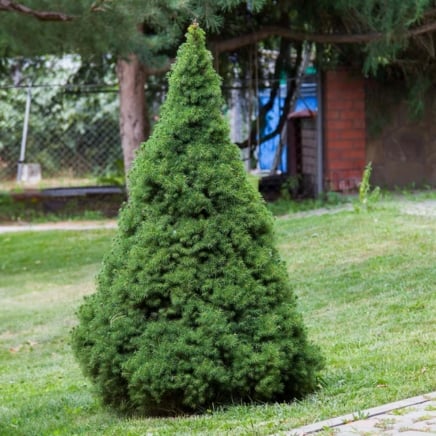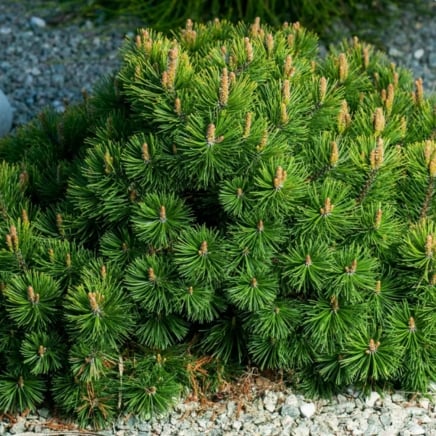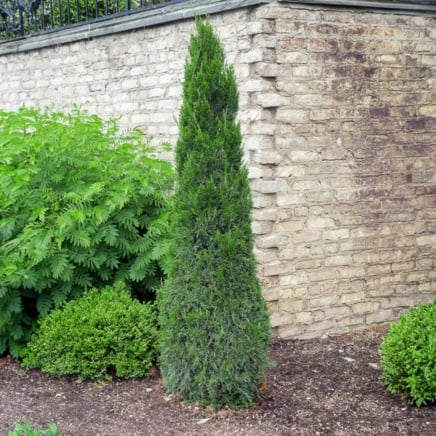PROTECT YOUR DNA WITH QUANTUM TECHNOLOGY
Orgo-Life the new way to the future Advertising by AdpathwayCold zone gardeners know the importance of evergreen plants! They offer texture, structure, and color during the winter months after deciduous plants lose their leaves. Evergreen shrubs are superb, as they stay low-growing and bushy throughout their lives.
The reality of having a garden is that you’ll have to prune some plants. Some may reach over their limits, while others may expand into the street or your neighbor’s yard. Though you’ll occasionally have to trim these evergreen species, it’ll be a rare occurrence. They stay within their bounds!
These 17 evergreens aren’t as high-maintenance as boxwoods, laurels, and ficus bushes. Trim them if you wish, or let them grow into a natural shape. No matter what you do to them, they’ll fill your garden with lush growth the entire year.
Dwarf Alberta Spruce

Pumilio Mugho Pine

Spartan Juniper

‘Blue Arrow’ Juniper
 It’s narrow enough for tight spots but bold with blue flair.
It’s narrow enough for tight spots but bold with blue flair.‘Blue Arrow’ juniper is blue and narrow like an arrow. It has evergreen foliage that grows up instead of out. A mature specimen will often stay less than two feet wide!
Perfect for tight, upright spaces, the ‘Blue Arrow’ juniper excels where other evergreens fail. It may reach upwards of 15 feet. Trim the top of it to keep it shorter, or plant it in an area where the top has room to expand.
Junipers dislike wet, soggy conditions. For the healthiest growth, plant your ‘Blue Arrow’ in a site with well-drained soil and plenty of direct sunlight.
‘Chirimen’ Hinoki Cypress
 They’re great for containers or tight garden corners with style.
They’re great for containers or tight garden corners with style.Hinoki cypresses are homeowners’ favorite evergreens. Many cultivars grow well in pots, while others stay dwarf-sized in the yard. ‘Chirimen’ is my all-time favorite Hinoki cypress—it’s low-maintenance, unique, and easy to grow.
Spires of growth emerge from the woody stems of ‘Chirimen’ plants. They resemble the hair of Sideshow Bob from The Simpsons. Fuzzy and dense, this growth is unlike that of any other conifer you’ve seen before.
This cultivar is low-maintenance. It’s slow-growing and short-statured, no matter how old it gets. You’ll never have to prune it; it’ll slowly grow bushy over many years in the garden. Plant it in a large container, or set it next to your doorway in the ground.
Dwarf Alberta Spruce
 This spruce is ideal for northern gardens where you crave year-round evergreen structure.
This spruce is ideal for northern gardens where you crave year-round evergreen structure.Dwarf Alberta spruce, or D.A.S., for short, is an attractive garden specimen. It’s a form of white spruce that stays bushy and dense in a perfect Christmas tree shape. Discovered in the wilds of Canada in 1904, this cultivar is an old favorite that has stood the test of time.
Because it’s a cultivar of the white spruce, this small tree prefers cool, moist conditions. It dislikes the heat that’s common to the southern U.S. Consider an alternative conifer if you live in zones 7 and above in the South. If you garden in cooler regions like the Pacific Northwest, the spruce will survive in zones 2 through 8.
Though D.A.S. is technically a small tree, it’ll perform like a shrub for most of its life. It’ll stay under 13 feet when mature, though it’s slow-growing and takes many years to get that tall.
Dwarf Mountain Pine
 It loves spreading out low and wide without much effort.
It loves spreading out low and wide without much effort.Like the dwarf spruce, the dwarf mountain pine is an old garden favorite with a wealth of uses for the yard. It’s an excellent container specimen, and it works well in a dry bed. Also called pumilio pine, dwarf mugo pine, and pumilio mugho pine, this mounding shrub rarely requires pruning.
Unlike pine trees, the dwarf mountain pine sprouts many candles on multiple branches that grow from its base. Candles are the points where new growth emerges from the pine in late winter and early spring. They’re typically shaped like fingers, and they’re often brown or yellow. If you’d like to reduce the height of your shrub, simply pinch these candles back by a third or a half.
Avoid planting this evergreen conifer next to a walkway, as it tends to spread wide rather than tall. It’ll flop onto the path and require pruning. Instead, give it an open spot where it can grow wide over many years.
Dwarf Golden Threadleaf False Cypress
 This false cypress makes a cheerful little mound in rock gardens.
This false cypress makes a cheerful little mound in rock gardens.Though its name is a mouthful, the dwarf golden threadleaf false cypress is an incredible conifer! It sprouts long, whip-like, and segmented leaves with a golden color. The brighter the exposure, the more golden leaves you’ll see.
This cultivar has a mounding habit. It stays short and stocky with cascading sprays of foliage. Set two inside containers on opposite sides of your doorstep, or plant them in a sunny spot in the yard. Other uses include rock gardens, bonsai, and short hedges.
Gem Box® Inkberry Holly
 It holds its deep green color straight through winter chills.
It holds its deep green color straight through winter chills.Gem Box® holly is the perfect boxwood replacement! It works well in regions where boxwoods struggle. Ideal for U.S. gardens, Gem Box® holly is a cultivar of the native plant Ilex glabra, or inkberry holly. The native parent plant grows wild throughout the southeastern U.S.
Grow Gem Box® in a container, use it for low-maintenance hedges, or plant a few as focal points scattered throughout the garden. Their evergreen leaves provide the perfect backdrop for colorful wildflowers and spreading ground covers.
Himalayan Sweet Box
 This evergreen spreads slowly and sweetly beneath tall trees or shrubs.
This evergreen spreads slowly and sweetly beneath tall trees or shrubs.Himalayan sweet box is another favorite evergreen of mine. It’s fragrant in spring, blooming white star-like blooms that smell of jasmine. Unlike most other shrubs on this list, sweet box grows well in the shade among hellebores and hostas.
Instead of growing from a central base, this shrub spreads through short, rooting stems that sprout anew in the spring. Plant it in a spot in the garden where it has space to roam, and you’ll rarely have to prune it. Give it well-drained, fertile soil that’s rich in organic matter like compost or leaf mold.
Dwarf Italian Cypress
 Tall and slender, it adds instant elegance to gardens.
Tall and slender, it adds instant elegance to gardens.You may already know about the Italian cypress. This dwarf variety performs well as a shrub. It’s an iconic evergreen species that reaches impressive heights, though it remains relatively narrow. It grows well without pruning—in fact, if you prune it wrong, it’ll do more harm than good!
Occasionally, you may need to trim long branches if they fall from snow or heavy rains. Avoid cutting the tops, as this will lead to poor growth in the future.
Many landscapers and landscape architects like to use the Italian cypress when designing formal gardens in warm regions. Its tall stature and narrow width make an impressive statement. Use two to frame a doorway, or make a living screen by planting multiple in a row.
‘Sunset’ Manzanita
 It prefers dry summers and gentle springtime moisture.
It prefers dry summers and gentle springtime moisture.‘Sunset’ manzanita is a natural hybrid that was discovered in California. Native to the state, it grows well in regions with dry summers and moderately moist winters and springs. Unlike sprawling manzanitas, this hybrid tends to stay compact and bushy.
If ‘Sunset’ grows too tall or wide, prune the branches when new growth begins to emerge. Some plants stay short under five feet tall, while others may reach up to eight feet.
This manzanita works well in containers with well-draining soil. Water it sparingly, and pull it out of the rain if it’s too wet in fall, winter, or spring.
‘Nana Lutea’ Hinoki Cypress
 Sunshine-yellow leaves brighten up small garden corners nicely.
Sunshine-yellow leaves brighten up small garden corners nicely.This selection of Hinoki cypress is a knockout for small gardens. ‘Nana Lutea’ sprouts sunshine-yellow leaves on short branches. The leaves turn bright green the more shade they receive. Mature specimens stay under five feet, making them ideal for growing beneath power lines and telephone poles.
Though technically a small tree, ‘Nana Lutea’ works well as a shrub in cold regions where other plants struggle. It’ll stand out in a rock garden as a focal plant or with others in a mass planting.
Oregon Grape
 This tough little shrub handles shade and dryness well.
This tough little shrub handles shade and dryness well.Oregon grape works well in other states aside from Oregon! It’s an evergreen shrub that tolerates dry shade, making it an exceptional choice for a shady garden. It requires no shaping, though it tolerates pruning if you’d like to control its growth.
In spring, yellow flower clusters emerge that feed local bees and pollinators. After pollination occurs between two separate Oregon grapes, fruits begin to form. They feed hungry birds in the fall as they turn a dull, dusty gray-blue.
If you want to prune an Oregon grape, do so right after it flowers. This will prevent fruits from forming, but it allows blooms to appear next year. Blooms and fruits form on old growth, so late pruning in winter and spring can prevent next year’s flower buds from forming. Remove tall stems, and preserve a few low ones to take their place.
PJM Rhododendron
 Compact types stay neat and perfect under three feet.
Compact types stay neat and perfect under three feet.PJM rhododendrons are a large group of hybrid rhodies that survive better than most others in harsh conditions. They’re common in office and commercial landscaping, as they grow well with minimal care. They’re also more cold-tolerant than other rhodies, working well outside the Pacific Northwest in areas like the eastern and northern U.S.
Find many hybrids available inside the PJM group. Try ‘PJM Compacta’ for a lower shrub that stays beneath three feet. Opt for ‘PJM Elite’ if you prefer large bloom clusters. Most cultivars have leaves that shift from green to maroon-purple foliage under cold temperatures.
‘Rotundifolius’ False Holly
 It grows dense and neat without much trimming fuss.
It grows dense and neat without much trimming fuss.‘Rotundifolius’ is unlike any other false holly! Instead of sprouting spiny leaves that prick you when you touch them, it grows round ones with smooth edges. They sprout close together on the stems, creating a bonsai-like look.
You don’t need to prune this evergreen false holly, though you may if you want to keep it shorter than eight feet. Never prune more than one-third of the plant at a time to avoid shocking it. Do so in spring so new growth emerges shortly after you make the cuts.
‘Sky Pencil’ Japanese Holly
 It stands straight like a natural green skyscraper outdoors.
It stands straight like a natural green skyscraper outdoors.Another upstanding and columnar cultivar, ‘Sky Pencil’ Japanese holly grows as its name suggests. It forms a pencil shape that reaches upwards in the sky! Narrow and dense, this evergreen variety is exceptional in formal gardens where structure and straight lines are necessary in the design.
‘Sky Pencil’ grows well in pots and containers, and it thrives in moist garden soils. Give it plenty of direct sunlight so it’ll stay healthy for seasons to come. Trim any unruly stems to keep the upright, narrow shape.
‘Spartan’ Juniper
 The naturally pyramidal shape makes it great for screens.
The naturally pyramidal shape makes it great for screens.‘Spartan’ juniper requires little to no pruning! It’s an elegant evergreen for harsh sites with recurring droughts and cold winter temperatures. With a naturally pyramidal form, it’ll form an evergreen screen en masse or work as a focal point as a single specimen.
‘Spartan’ takes many years to reach upwards of 15 feet. Trim its edges if you’d like to, but avoid cutting into the wood. Junipers don’t sprout new growth from cut wood like boxwoods. Prune sparingly, if at all.
‘Standishii’ Yew
 This slender, neat evergreen shines in any garden.
This slender, neat evergreen shines in any garden.English yews are giant trees, though many cultivated hybrids are smaller trees and shrubs. ‘Standishii’ is a standout among the many varieties because it stays compact, dense, and narrow as it matures. Its bright yellow new growth in spring contrasts beautifully with the darker green foliage beneath.
Like ‘Sky Pencil’ holly, ‘Standishii’ yew forms a pencil shape as it grows. Compact, narrow stems sprout close together off a central trunk. You won’t ever need to prune them!
‘Whipcord’ Western Red Cedar
 It takes its time to grow, but steals the garden show.
It takes its time to grow, but steals the garden show.‘Whipcord’ western red cedar looks like Cousin Itt from The Addams Family! Instead of evergreen sprays of foliage, it grows thin, whip-like leaves in all directions. They turn bronze in winter and green in spring and summer. Their shifting colors make an impressive statement in the conifer garden.
‘Whipcord’ is slow-growing and maintenance-free. You won’t have to prune it. It’ll take decades to grow to five feet tall, and then it’ll remain in a rounded shape that tucks nicely next to other shrubs and small trees. Trim the ends if necessary, and avoid cutting into the wood.


 1 week ago
15
1 week ago
15





















 English (US) ·
English (US) ·  French (CA) ·
French (CA) ·